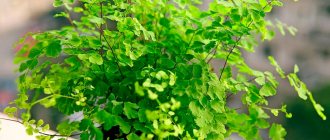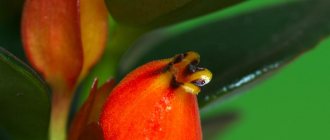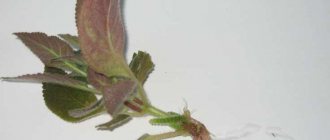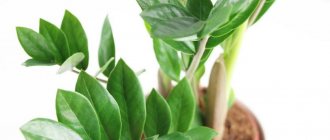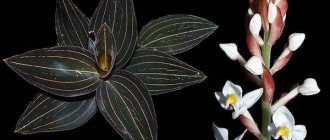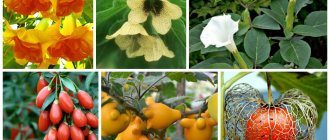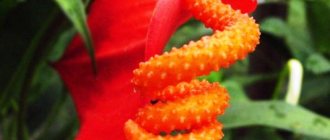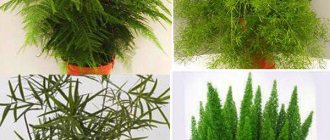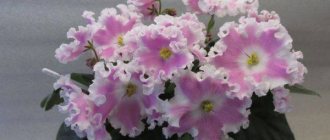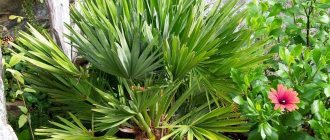Brief description of cultivation
- Bloom . At home, callisia flowering is a rather rare occurrence. As a rule, this happens in the last summer or first autumn weeks.
- Illumination . Grows well in light shade or in diffused bright light.
- Temperature regime . In the spring-summer period - from 20 to 24 degrees, and in the cold season - from 16 to 18 degrees. Make sure that the room is not colder than 14 degrees.
- Watering . During the growing season, the bush is watered immediately after the top layer of the substrate has dried. In winter, the soil mixture is moistened only after it has dried to a depth of 1/3.
- Humidity . Requires high air humidity. On hot days, you need to systematically moisten the foliage with a spray bottle.
- Fertilizer . The flower is fed in April–October once every 15 days, using a solution of a mineral complex. In other months, the plant is not fed.
- Rest period . November–March.
- Transplant . While the bush is young, it is replanted regularly once a year, and older specimens are subjected to this procedure less often (once every 2 or 3 years).
- Reproduction . Layering, apical cuttings and dividing the rhizome.
- Diseases . The decorative quality of the plant may suffer due to improper care or unsuitable growing conditions.
- Pests . Spider mites and thrips.
- Properties. The flower reacts extremely negatively to tobacco smoke.
Where is Callisia from?
Homeland of Kallisia
South America is considered, and more precisely, its subtropical and tropical regions. She loves humid places with partial shade. Callisia is also widespread in Mexico and the Antilles.
In the natural range there are about twenty species of Callisia. But in indoor and greenhouse floriculture, several species of this amazing plant are known. We'll talk about them a little below.
How to care for callisia
The plant has some requirements for lighting - it should be bright, but diffused. To place the pot, you need to choose a bright or slightly shaded place in the house. The more intense the light, the brighter the leaves.
The plant prefers warm rooms with a temperature of 20-25 degrees during the spring-summer period, and in winter - not lower than 14 degrees. Sudden changes in temperature are harmful.
For the plant, you need to create conditions with high air humidity. To do this, it is necessary to regularly but carefully spray with water at room temperature.
Caring for callisia at home is not very difficult. For irrigation you need to use soft, settled water. If you need to water abundantly in summer, then reduce the frequency of watering in winter. Drying the soil should be avoided.
The boat-shaped plant requires even less watering in winter than other types. The plant needs regular feeding during the period April-September.
- Bacopa - description of the species, cultivation, care, reproduction + 74 photos
Garden hibiscus - types, description, planting, care and propagation + 69 photos
- Celosia - growing from seeds and seedlings, planting in the ground and care rules + 80 photos
Nutrients are added every week. Complex mineral fertilizers are preferred.
What does it look like
The plant is decorative, the length of the stem does not exceed 15 cm. The shoot spreads, so it is placed in hanging flowerpots. A more famous type of plant is fragrant callisia, or golden mustache. The creeping variety is a different species.
Callisia creeping
If the first plant has oblong leaves up to 20-30 cm long, the second is distinguished by small heart-shaped elements in two rows on the stem. The front surface is green, the back is lilac-violet. The visible part of the leaf is dotted with small purple dots.
For your information! It blooms extremely rarely indoors, when small white elements appear in the leaf axil on a thin branch.
Callisia grows quickly and in natural conditions covers the ground with a carpet. Prefers rocks and stones, forming garlands on them. Creeping callisia is a species that is not similar in appearance to the golden mustache.
Medicinal properties and varieties
Collision or “Golden Mustache” has a very wide range of medicinal properties. The aroma of this plant helps get rid of nightmares and insomnia; its juice contains useful substances that increase immunity, heal wounds, and ulcers. It is also used to treat intestinal diseases, liver diseases, and skin diseases. An ointment prepared using the juice is used to treat joints and for cosmetic purposes. However, you should not overuse the golden mustache.
Note! The juice must be diluted; during the period of taking conflict-based products, it is better not to consume soda, baked goods, or dairy products.
Golden mustache is contraindicated for pregnant and lactating women, children under twelve years of age, people suffering from renal failure or prostate adenoma.
There are about twelve types of collision, but the most popular among them are:
- Graceful - a plant 30-40 cm high, with a strong creeping stem, velvety leaves decorated with silver stripes, purple on the reverse side.
- Creeping is one of the smallest representatives of the plant variety, no more than 10 cm in height. It grows quite quickly and at the same time spreads over the surface like a carpet. A distinctive feature of the creeping plant is purple specks on the leaves and a burgundy tint on the reverse side.
- Fragrant, also known as "golden mustache".
This is a medicinal variety of a wonderful plant. The fragrant flower has thick, fleshy leaves, which are oblong, erect, and up to thirty centimeters long. The stems of the golden mustache are found erect, but most often creeping, ranging in height from seventy to one hundred and fifty centimeters; - Scaphoid - has a short stem with thick leaves filled with juice; it belongs to succulents.
The leaves are green on top but can turn red if exposed to too much sunlight. The leaves below have a beautiful purple-brown tint. - Collision Tehuatepen - distinguished by the absence of white stripes and bright pink flowers.
These are the main varieties, but there are many more of them in nature.
Kinds
The Callisia genus includes 12 species of plants, but the following 5 are suitable for indoor keeping.
Callisia elegans (elegant or graceful callisia).
The height of this variety can reach 40 cm. The shoots have a creeping appearance. The color of the leaves is dark green, their upper part is decorated with white stripes, the lower part is purple. The shape of the leaves is oval, the tips are pointed. The stems and leaves have a fleecy structure. During flowering, white buds grow at the tips of the shoots.
Callisia tehuanttepecana (Tehuantepec).
Resembles an elegant variety, but its leaf blade lacks light stripes. Blooms with bright pink flowers.
Callisia navicularis (scaphoid)
The stems of this species are short, the leaves are green in color, and brownish-purple on the inside. The leaves are boat-shaped, their length is 2 cm, width is 1.5 cm. If the crop is kept under bright sunlight, the leaves become covered with a scarlet tint.
Callisia repens (creeping)
This variety grows up to 10 cm and is characterized by fairly rapid growth. The stems of the crop are thin. This is a small-leaved plant, the length of the leaves is no more than 2 cm. The outer side of the leaf blade is covered with pale purple specks, and a burgundy tint is noticeable on the inside. This is one of the most popular indoor types. The Pink Lady variety is especially in demand among flower growers.
Callisia fragrans (scented or "golden mustache")
The height of the plant can reach 1.5 m. The specimen has erect and horizontal shoots. On erect stems, the leaves grow up to 30 cm in length, their width is 5-6 cm. Horizontal sprouts are tendrils with leaf panicles. This species blooms at the end of winter, however, at home, flowering is a rather rare occurrence. The buds are small, modest, and primitive.
Varieties
Callisia is an evergreen perennial from the Commelinaceae family. May have creeping or erect stems. The last option is less common. Leaf blades are lanceolate-shaped with an angular tip. They come in pairs and have no petioles. The color of the leaves is usually uniform green. Although there are also variegated varieties that have white veins on the outside and scarlet stripes on the inside.
Attention!
Some varieties can cause allergies in cats and dogs. It manifests itself in the form of redness and itching.
Callisia can be grown as a ground cover or potted plant. Thanks to the large number of shoots and densely spaced foliage, it looks beautiful. Its compact size allows it to be planted in wide ceramic vases along with other, taller plants of the same color. Callisia is often mistaken for Tradiscantia. However, this is wrong. These are different plants, despite the fact that they are similar in appearance and belong to the same family. Flower growers grow several types of callisias.
Elegant (graceful)
This is a miniature species with geniculate creeping stems more than 50 cm long. At first they grow straight, but over time they droop. The plant reaches a height of 30-40 cm. The stems and leaf blades are velvety. The length of the latter is 3-6 cm. Their upper part is dark green with white stripes, and the lower part has a purple tint. Flowering occurs in August-September. At this time, white buds appear at the ends of the shoots. The lifespan of the elegant callisia is short. After about 2 years, the number of leaf blades is reduced, and their color loses saturation. This problem is solved by propagating the plant. A new callisia obtained at home has the same parameters as the original mother plant.
Caring for callisia at home
Lighting and location selection
Indoor collision needs a lot of bright light, which should be diffused. Be sure to shade the bush from direct sunlight. If the room is sunny, then the bush can be placed away from the window. It is extremely undesirable to place this plant in the kitchen, because it reacts negatively to various fumes, tobacco smoke, impurities in the air, etc. In order for callisia to feel good, it needs to be provided with regular ventilation of the room, and it can be moved during the warm season to the street or to the balcony.
You can decorate not only your apartment or dacha with callisia; it also feels quite normal in the office. However, special attention must be paid to ventilation. Avoid drafts, as they are even more dangerous for the plant than stuffiness.
Temperature
Callisia feels normal in the summer at temperatures from 20 to 24 degrees, and in winter - from 16 to 20 degrees. But remember that the flower must be protected from cold and sudden temperature changes. Make sure that in winter the room is not colder than 14 degrees.
Watering
In spring and summer, soft water is used to water the collision, the temperature of which should be close to room temperature. The substrate in the pot is moistened immediately after its top layer dries. In autumn and winter, the collision is watered less frequently and sparingly, especially if it is in a cool room. But remember that the soil mixture in the pot should not dry out completely, as this can lead to the death of the bush. Also, make sure that when watering, the liquid does not get into the middle of the leaf rosette, otherwise the plant may rot.
Spraying
Because of its love for high levels of humidity, Callisia repens requires irrigation. If you apply it with a coarse spray, then streaks will remain on the plate. Therefore, it is better to purchase a fine spray nozzle.
Note! From time to time you can arrange a shower for the foliage by placing it under heated running water.
Humidity
The recommended humidity level for the plant coincides with the optimal parameter in a house for people to be in - 60-70%. To achieve this level in temperate latitudes, you need to use a humidifier. To maintain optimal conditions, it is removed from the battery in winter.
Callisia pot
After purchasing a plant from a flower shop, it is not replanted. When the young planting grows slightly, you can replant it. To do this, choose the right container: the pot should be wide, but have a small depth.
It is better to choose a container made of ceramic, but often people buy plastic pots - they are also suitable.
One of the important conditions is the presence of a durable, spacious pallet.
Priming
There are ready-made soil mixtures for tradescantia and callisia on sale, since they belong to the same family. You can prepare the composition yourself. The requirements for the substrate are simple: it must be nutritious, not retain excess moisture, but also not be overly porous. These parameters correspond to a mixture of peat, humus, sand, turf and leaf soil.
Callisia transplant
Feeding
Callisia needs feeding during the active period. A complex fertilizer for tropical flowers is used. Fertilization regime: weekly, from April to October.
Trimming
Like any plant, callisia needs timely pruning when cared for at home. It is better to do this in the spring, when there is abundant growth of shoots. Pruning helps give the bush its traditional shape.
To make the plant more lush, several cuttings are planted in a pot at once. The planting tolerates pruning painlessly.
Features of plant propagation
To obtain a cutting, the top of the callisia is cut off at a distance of 2 “joints” from the rosette of leaves. The cut is made in . The cuttings are rooted in plain water, and after 7-10 days, when the root has formed, it is transplanted into the ground. Complete rooting occurs in 2-3 weeks.
The procedure for planting fragrant callisia is not too complicated. This is due to the fact that its horizontal shoots take root easily. The trunk must be secured to a strong support. The side shoots will hang down and gradually take root in the ground.
To speed up the process, they are lightly sprinkled with earth. When the shoot is firmly rooted, it is separated from the stem. After which you can already replant.
The most suitable is humus soil. It may contain turf or deciduous soil. Requires the addition of humus, peat and sand. A mixture of turf, humus and sand also works well. Be sure to place drainage at the bottom of the pot or vase.
Fragrant callisia is not only an ornamental houseplant, but its medicinal properties are also known.
There are many varieties of callisia that can be grown at home. They are quite easy to care for and unpretentious, but allow you to create attractive living sculptures.Transfer
Some experts recommend planting a new flower instead of replanting. This is explained by the fact that the stems of the plant become bare with age and its decorative value decreases. If a flower lives in the house for a long time and you are used to it, then it is better to replant it. This is done annually with young plants, and with adults – after two to three years. The florist decides what to do.
The plant needs to be replanted into another container with good drainage and new soil. This can be done throughout the year, but better in the spring. You can prepare the soil yourself. To do this, turf and leaf soil from the garden, humus, peat and sand are taken in equal proportions.
Reproduction of callisia
Callisia is propagated by cuttings. To do this, cut off the upper part of the shoot and place it in a glass of water. After 2-3 weeks, after the roots appear, the cutting can be transplanted into a pot.
Another way is by layering. To do this, there should be enough space in the pot or you can place another container nearby. To reproduce, you just need to dig in a shoot, which will give roots after a while. The plant can be propagated at any time of the year, but it is best in spring or summer.
Benefits and harms
Creeping callisia, like its other varieties, has a positive effect on the body. Its juice is rich in minerals and vitamins. Beta-sitosterol in callisia helps with atherosclerosis, thyroid diseases, metabolic disorders and other diseases. From the practice of traditional healers, it is known that the medicinal properties of callisia are similar to ginseng and Rhodiola, although this has not been proven by science. When a disease occurs, each person decides for himself whether to be treated in the traditional way or in the folk way. But what has been definitely proven is the cleansing effect of the plant.
By planting a flower, apartment owners receive a free and very beautiful air purifier. The energy of creeping callisia has a positive effect on the home atmosphere. With this plant, peace and mutual understanding reign in the house. The antiseptic properties of flower phytoncides have a beneficial effect on humans. Therefore, it is recommended to place it in the bedroom for children. The blooming of callisia is the first sign that the energy in the room is positive and there are no problems in the house.
"Golden Us" or callisia: types, application
Callisia (lat. Callisia) is an ornamental leaf plant belonging to the Commelinaceae family. The genus consists of 12 species, some of which are cultivated at home. In floriculture, fragrant Callisia (lat. Callisia fragrans) or “Golden Us”, elegant callisia (lat. Callisia elegans) and creeping callisia (lat. Callisia repens) are usually grown. Despite the fact that the different types bear little resemblance to each other, their care is the same.
Fragrant callisia (Callisia fragrans) is native to the tropical forests of South America. We most often call it “Golden Mustache”. In its homeland, under natural conditions, this is a powerful herbaceous plant that grows up to 2 meters in height, has long leaves and creeping shoots. It has been grown as a houseplant for over 100 years...
Fragrant callisia is distinguished by its large size and two types of shoots. Some are erect, succulent, up to 80 cm high, with large, shiny, bright green alternate leaves. Other shoots extend from these shoots - horizontal, similar to aerial stolons, with underdeveloped leaves, ending in rosettes of young leaves. If you tear a leaf in half, you can see thin yellow threads, the vessels of leaf tissue, stretching between the halves. That is why they call it “Golden Us”. Sometimes it blooms, but only with good care. The flowers are small white or pinkish, fragrant, the smell is subtle, very delicate, pleasant, reminiscent of the smell of lily of the valley or hyacinths.
Callisia flowers are collected in axillary inflorescences in the form of simple or double curls. After flowering, capsule fruits are formed. There is a variegated form.
Callisia elegans is a perennial herbaceous plant with creeping stems. The leaves are ovate with a pointed apex, 2 cm long and 0.5-1 cm wide, velvety above, dark green with longitudinal silver-white stripes along the veins, purple below. The entire plant is velvety-pubescent. At the end of summer - beginning of autumn, graceful callisia blooms with white, inconspicuous flowers. The flowers are small, located on the tops of the shoots.
Creeping callisia (Callisia repens) A dwarf plant with miniature leaves, barely reaching 0.5-2 cm. Upon careful examination, purple specks are noticeable on the leaves. Thin stems bear two rows of leaves. Creeping callisia grows very quickly, forming a continuous low green cover.
Lighting
All southern plants love the sun most of all, so it is advisable to grow the plant on the lightest windowsill, but it is better to protect callisia from direct sunlight by shading.
Place the plant in partial shade or in bright diffused light, temperature in summer - +18-22 °C, in winter - +15 °C. It is best kept near windows facing west or east.
Watering
The plant should be watered moderately, not allowing the soil to dry out. The soil should be evenly moist. Tolerates insufficient air humidity. Requires frequent and regular spraying.
Top dressing
Feed during the growth period, from March to October, once a week with mineral fertilizers. Tolerates pruning well. In the spring and summer, it is necessary to regularly feed with complex fertilizers for decorative deciduous plants. Dosage and frequency are prescribed in the manufacturer's recommendations. From mid-autumn, fertilizing needs to be reduced. If the plant is kept cool, there is no need for fertilizer.
Reproduction
Old shoots become bare at the base, so it is more advisable not to replant, but to renew them from apical or stem cuttings, which easily take root in water. Cuttings take root completely in 2 - 3 weeks. Fragrant callisia also reproduces well by layering. For splendor, it is better to plant several cuttings in one pot.
Transfer
Callisia needs to be replanted approximately once every 2-3 years. If the pot has become too small for an overgrown plant, then you can do it more often. It is better to replant in spring or late February. At this time, light conditions improve, which in turn encourages the flower to grow. For potassium, it is better to choose shallow pots proportional to the size of the plant. The root system develops well in them. To improve air exchange, place drainage on the bottom. Callisia is not picky about soil. Any loose and nutritious mixture will do. The soil should be made up of equal parts of leaf, humus, peat soil and sand.
Diseases and pests
Pests: aphids, cyclamen mites. The most common pest is the spider mite. To destroy it, it is enough to treat it a couple of times with an acaricide (Fitoverm, Actellik, etc.) with a week break. Prepare the solution according to the manufacturer's instructions. In case of damage by any other pests, it is enough to water the plant once with a systemic preparation (Aktara)
Medicinal properties
In addition to its undeniably high decorative features, golden mustache is known as a medicinal plant. Fragrant callisia has a number of active biological substances that can fight various types of infections, strengthen the immune system, stimulate metabolic processes, and promote the removal of toxins from the body.
It has a wound-healing effect and relieves pain well.
The medicinal properties of fragrant callisia have been studied and described by pharmacists around the world. It has been proven that the plant’s healing power is not inferior to ginseng. The famous herbalist Vladimir Nikolaevich Ogarkov has been studying the medicinal properties of the “Golden Mustache” for almost 20 years. He developed and put into practice many recipes using this miracle plant.
Mistakes and care problems
Errors in caring for callisia are associated with violation of the rules for its maintenance. Knowing about the tropical origin of the flower, the owners place it on the window in the hottest place, in winter - closer to the radiator.
If there is a cat in the house, then you need to protect the flower from its teeth, since animals love to eat indoor flowers. If placed in a draft, it will die. If you allow a temperature drop in winter, the leaves will lose moisture and become flabby. The sprouts will die.
Callisia is a plant from the Tradescantia genus that grows naturally in tropical latitudes. About 12 types of flowers are grown as indoor plants. Callisia propagates by cuttings and layering. Requires frequent watering and irrigation in the summer.
Plant care
Caring for callisia is not difficult and does not take much time. In terms of growth rate, according to the scale of professional flower growers, it belongs to the middle class. Follow the recommended instructions for caring for the Callisia flower, and your home will be decorated with a fluffy, charming plant.
Conditions of care
Lighting and location
Callisia is not a plant for south-facing window sills during hot periods. A lover of light, but at the same time beware of direct contact with the sun's rays. (Heteropanax grows well in the same conditions). A favorable place for a flower pot is a stand, away from the scorching sun, or eastern and western windows. A completely shadow location is also contraindicated, because the leaves lose their attractiveness and become dull. Please note one more thing: callisia does not like kitchen, tobacco and foreign odors. The most comfortable place for location is an office, study, and in the summer - a balcony, veranda, loggia.
Room temperature
Moderate warm air is suitable for indoor callisia plants. In winter it can easily withstand a slight cold snap, but not below +15°C. On hot days, the temperature should not exceed 25°. It is not very sensitive to temperature changes, but sudden changes are contraindicated for the plant.
Air humidity
Callisia does not like dry air, but loves shower procedures with weak dissipative water pressure. Monitor the humidity in the room where callisia grows, ventilate the room regularly and spray. It is good if there is a container of water or humidifiers programmed at a level of 60-70% humidity near the flower pot. Wipe the large leaves of the plant to remove dust with a damp cloth.
Watering callisia
Using a toothpick or any other wooden stick, check the need to water the plant. If the soil is dry at a depth of 3-4 cm, it’s time to water the callisia. Watering is done closer to the edges of the flower pot rather than to the center of the plant to avoid rot. Use filtered water or soft rainwater, tap water and let it sit for 24 hours. Water the plant abundantly, sparingly and less often in winter.
Trimming
Callisia should be pruned regularly; cleaning time is spring. The dry shoots and babies that appear on the mustache should be completely eliminated. Pruning helps callisia maintain its shape and properties. Pruning a plant is a painless process.
Fertilizer and feeding
From spring to autumn is the time to fertilize the plant. Top dressing is prepared from a complex of minerals, the procedure is carried out once or twice a month.
Plant propagation
Transfer
Flower growers generally do not engage in replanting; callisia retains its attractiveness for a long time. But if you decide, then replant no more than once a year or less often, according to standard rules - damaged stems and leaves are removed, and freshly preserved ones are planted in the soil on the drainage.
Reproduction
Cut off the tops of the plant with two or three nodes, and place the cuttings in water for rooting. After the cuttings begin to develop, plant several of them in the ground in one flower pot. For propagation by layering, dig in the third node before rooting. Then separate it from the main plant and plant it in a separate pot. Callisia successfully reproduces with a mustache. Callisia can be propagated at any time of the year.
Priming
The basis of the soil is drainage and nutrient soil. The composition of the nutrient soil includes part of the turf soil, 3 parts of humus and 1 part of coarse sand.
You might be interested in:
Pests, diseases and problems of callisia
The plant by its nature has good immunity to diseases, and pests usually do not bother it. But problems still arise due to improper care. In particular:
- With a lack of light, the plant begins to stretch.
- Little fertilizing means the growth of callisia slows down.
- A lack of minerals will affect the pallor of the leaf.
- Callisia will react to a decrease in temperature, the leaves will lose their elasticity and become soft.
- When watering the plants, water was allowed to get into the core - the leaves would rot.
- If the indoor air is dry, brown, painful spots will appear on the callisia leaves.
- Among the pests that can cause damage to the plant are scale insects, spider mites, and aphids.
Diseases and pests
Callisia when grown at home is subject to the following problems:
- Callisia stems stretch out - the plant does not have enough light.
- Callisia grows slowly - there is a lack of fertilizing.
- Small and pale young leaves - lack of mineral fertilizers.
- Callisia leaves are soft - the ambient temperature is too low.
- The bases of the leaves rot - liquid gets into the center of the rosette when watering.
- Brown spots on callisia leaves mean the air in the room is too dry.
- The plant grows quickly - it is considered a natural process; to prevent it, rejuvenation by cuttings is used.
Among other common problems, plant growers note root and stem rot. Diseases appear due to the moisture of the earthen clod and improperly organized drainage. Pests that attack callisia: spider mites, thrips and scale insects.
Possible problems
Callisia is susceptible to rot. The disease develops due to too frequent watering or lack of drainage. The problem is eliminated by removing the affected parts and further processing the cuts with charcoal. For better effect, change the soil to a new one. In case of significant damage, additional treatment with fungicides (Oxychom, Bayleton) is performed.
Problems often arise due to violations of care rules. To understand what mistakes were made, evaluate the symptoms:
- Drying of the ground part - too infrequent watering.
- Brown spots on leaf blades indicate low air humidity in the room.
- Slow growth, small size and pallor of young foliage - lack of nutrients in the soil.
- Excessive softness of the sheet plates means the air temperature is too low.
- Rotting of the bases of the leaves - when watering, water gets to the center of the rosette.
Attention!
If callisia leaves turn yellow and fall off, this indicates that the plant is suffering from too much light or waterlogging.
Thrips and spider mites are dangerous pests for the plant. Pests bite through the leaf blades and draw out the juice. As a result, the plant withers and gradually dies. Insecticides are used to combat thrips, and acaricidal preparations are used to combat ticks. The treatment is carried out outdoors, since both products are toxic to people and their pets.
For many years, callisia has not been inferior in popularity to other ornamental plants, including those that are distinguished by lush, beautiful flowering. Among its advantages are unpretentiousness, high phytoimmunity, and easy reproduction. In order for callisia to be as lush as the photo, basic care at home is enough. She has no serious shortcomings.
Medicinal properties of fragrant callisia
For a long time after the plant was introduced into cultivation in Europe as an indoor flower, it served a purely decorative function. But at the beginning of the twentieth century, chemical and botanical studies were carried out, during which the presence of a number of healing components in the composition of its plant juice was confirmed. Repeated studies took place in the 80s on the basis of the Faculty of Pharmacy of the Irkutsk Medical University, where a group of young scientists set the goal of finding out whether drugs made on the basis of callisia are so effective. During experimental development, the presence of two valuable flavonoids in parts of the plant was confirmed - quercetin and kaempferol, cholesterol-lowering sitosterol and many useful elements such as copper, chromium, iron and others.
Of course, one should not consider callisia and the remedies derived from it as a panacea for all diseases, but their proper use can really have a beneficial effect on the body and become an effective aid in the treatment of many ailments.
Like all home-made herbal preparations, callisia derivatives should be used with great caution and with competent medical support.
How does it reproduce
There are several ways to propagate a plant; they differ in the degree of simplicity and speed of obtaining the final result.
Important! The plant can be propagated all year round, but shoots take root better in spring and autumn.
Support
The plant grows quickly, so it needs to be provided with support. To do this, you can install a peg and tie the stem. If it is not there, you can tie a string to the fastening of the flowerpot and shoot along it.
To give the plant the desired shape, you can place a frame made of thick wire crosswise in the pot. A shoot will begin to take off along it and wrap around it as planned.
Apical shoots
The simplest method is cuttings. To obtain a vegetative shoot, you need to separate a part of the stem, consisting of two internodes, from the top. Next, this part is rooted in the soil or placed in water so that the shoot takes root.
By layering
The essence of the method is that part of the stem can be buried in the ground, and after a while it will take root. To implement it, you need a large pot. The second option is to place another container nearby and place the sprout there. When the shoot takes root, it is cut off from the mother bush.
Species diversity
The callisia plant has many varieties that take root well in indoor conditions:
Elegant is a very small plant. It has strong and quite juicy creeping stems. A special feature is the beautiful velvety, egg-shaped leaves. Their color is dark green and purple underneath.Silvery stripes are visible on the surface. The leaves are 3-6 cm long. They are arranged in 2 rows on each shoot.
Scaphoid callisia is a succulent. Its leaves are similar in appearance to a boat. Under bright sun they have a red tint.
This is a fairly light-demanding species that needs to be watered infrequently. Shoots can be short or elongated.
Creeping is a small plant whose leaves do not exceed 2 cm in size. Purple dots are visible on their surface. The stem is thin, with leaves arranged in two rows. It is distinguished by its ability to grow quickly.
Fragrant, which is also called golden mustache. A plant with fairly large leaves 30 cm long has a height of up to 1.2 m. The leaves have a shine, and in bright light they acquire a pink tint.
Thick stems can be vertical with a large rosette or horizontal, on which leaves are placed in a spiral.
The photo of fragrant callisia shows that the plant can throw out horizontal shoots. This happens when the collision becomes mature. A rosette of leaves appears at the ends of the shoots.
- Clarkia graceful - varieties and types, care and planting, diseases + 78 photos
- Irises - description of the species, cultivation, reproduction + 102 photos
Campsis - planting, care, location rules, watering, types of reproduction (67 photos + video)
Propagation by cuttings
To do this, the apical shoots are cut off so that there are two or three nodes on them and placed in water. Very soon roots will appear on the cuttings. When they get stronger and develop, they are planted in a pot with soil. You can place several seedlings in one container, this will make the flower more decorative.
Sources
- https://rastenievod.com/kalliziya.html
- https://zeleniydrug.ru/kalliziya-callisia/
- https://KomnatnieCveti.ru/sadovye/kalliziya-dushistaya.html
- https://stroy-podskazka.ru/kalliziya/opisanie/
- https://komnatnie-rastenija.ru/kallizija-vyrashhivanie-i-uhod-v-domashnih-uslovijah-foto-vidov/
- https://greensotka.ru/dekorativno-listvennye/kallizia-polzucaa.html
- https://FB.ru/article/352813/kalliziya-polzuchaya—opisanie-uhod-v-domashnih-usloviyah-i-osobennosti-vyiraschivaniya
- https://tsvetem.ru/listva_v_dome/rastenie-kalliziya.html
[collapse]

